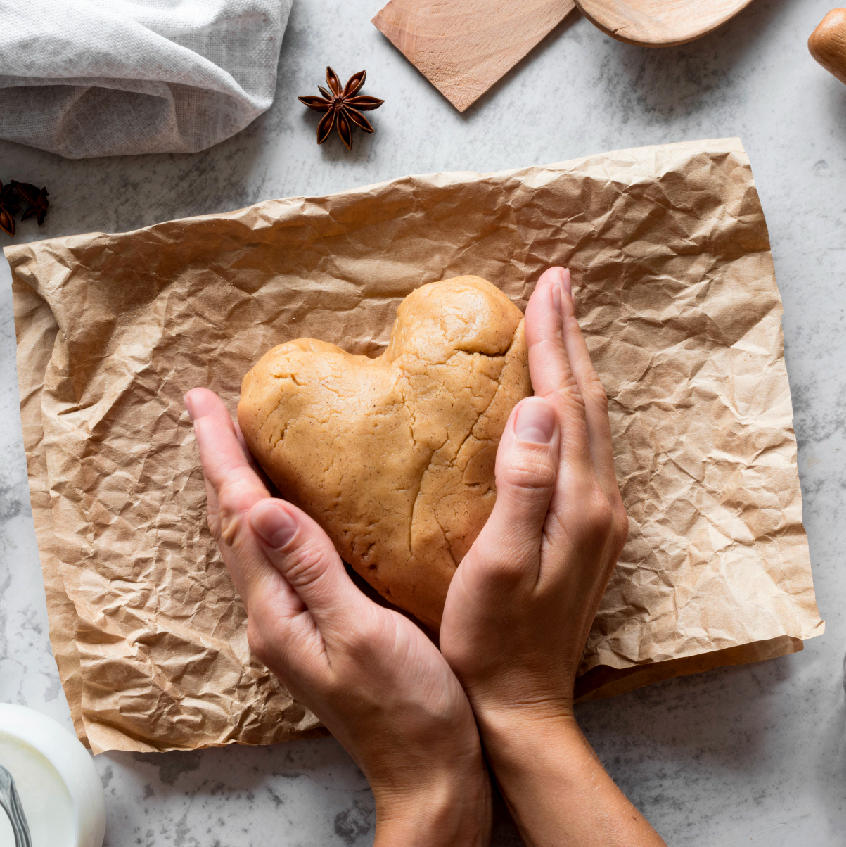In Wielkopolska (Greater Poland), Christmas is called Gwiazdka. This name has also spread in other regions of Poland. It probably refers to the custom of sitting down to Christmas Eve supper when the first star appears in the sky. This custom is still continued, and the supper is the culmination of Christmas also because of the wonderful dishes appearing on the tables, but it is worth remembering that the contemporary Christmas menu is quite different from the historical one.
Christmas Eve dinner begins with the sharing of wafers, and in some homes wafers (sometimes specially colored) are also given to pets. On the table there are traditionally 12 dishes (less often a multiple of this number) or an odd number of them (5,7,9 or 11), which depends on the individual choice of hosts and their traditions or wealth. The legendary Polish ethnographer Oskar Kolberg wrote a lot about 19th century festive cuisine of Wielkopolska. He noted that nine dishes were served on Christmas Eve table such as poppy seed soup, field peas with oil, cabbage with oil, dried mushrooms fried in oil, fried herring, blueberry noodles, sweet noodles with poppy seeds, dried pears and apples. Fish was served rather in rich houses, and among other exquisite dishes typical for our region Kolberg enumerated almond soup, dumplings with sauce, carp in gray, pike with saffron, wafers with poppy seeds or dumplings with honey and poppy seeds, boiled dried pears and plums. In the countryside people also ate siemieniucha, which is a soup made of hempseed.
The dishes that we know from our tables originate from the interwar period and the first years after the World War II. At first, fried fish, beet borscht and mushroom soup started to appear on the menu. A novelty and curiosity was rice served with prunes, raisins and cinnamon. In the post-war period there were big changes in the Christmas cuisine caused by migrations, marriages of couples coming from different regions, and finally the influence of the media. There was also some unification of the set of Christmas Eve dishes. There were mainly soups: borscht, mushroom and fish white soup, and sometimes whitewashed soup from dried fruit. On the tables of Wielkopolska herring, served among others in sour cream, cabbage with mushrooms, makiełki prepared in various ways and dried fruit compote remained. Polewka made of hemp and flaxseed, and poppy seeds has disappeared. Groats are almost never eaten and peas are quite rare, replaced by beans, and if they are eaten, it is usually with cabbage. For dessert we eat fruit, mainly apples and citrus, nuts, dried fruit compote and cakes: poppy seed cake, strucla or gingerbread. Particularly noteworthy are the above-mentioned makiełki. In one part of Wielkopolska they are made by slicing a wheat roll and soaking it in milk, then adding poppy seeds, honey or sugar and raisins. Elsewhere, instead of milk, it is soaked in water. In other parts of Wielkopolska makiełki are simply noodles with poppy seeds.
Christmas Eve supper has always been a very lavish - although fasting - meal. Tradition ordered to taste every dish. Contemporary times brought further changes. Obligation to observe fast has disappeared, Wielkopolska people more and more often taste such dishes as pierogi and kutia, and the place of domestic herring and carp is taken by salmon or even shrimps. This has little to do with tradition, but what matters is the joy of holidays and being together.
Recipes
Traditional baked carp (Tradycyjny pieczony karp)
4 slices of carp, 2 peeled lemons, 2 peeled onions, salt, pepper, breadcrumbs, one cube of clarified butter or margarine
Cut the slices into smaller portions, season with pepper and salt, place in a bowl with lemon slices and onion rings. Leave to cool for about 24 hours. Then coat in breadcrumbs. Preheat the oven to 170 degrees, melt the butter on a baking tray, put the fish on it and bake for 1 to 1.5 hours. During baking, after 30 minutes, gently turn over to the other side and take care that the portions do not stick to the sheet. The finished fish should be browned and soft, not dry.
Cabbage with mushrooms (Kapusta z grzybami)
1.5 kg sauerkraut (not salads), 150 -200 g dried mushrooms, 2 tablespoons of butter, salt, pepper
Rinse dried mushrooms, pour water over them, leave for 2-3 hours, then cut into strips and cook in the water they soaked in. Rinse the cabbage, chop it, put it in a pot with water and boil for 1,5 h. Then add cooked mushrooms with the soaking water to the cabbage. Boil the mixture, add butter, mix, season gently with salt and pepper.
Dried fruit soup with noodles (Zupa z suszonych owoców z kluskami)
500 g of dried fruit mixture (plums, apples, pears), 1 liter of prune compote with fruit, 250 ml of cream, a few cloves, sugar to taste
Cut the fruit into strips and pour warm water over them. Leave for a few hours and then boil. Add the fruit compote and boil for 15 minutes with the addition of cloves or sugar. Then add cream. If you prefer thick fruit soups, you can thicken it slightly with a bit of potato flour dissolved in a small amount of water. Serve hot with pasta such as spider noodles or mashed potatoes.
Makiełki for lazy people (Makiełki dla leniwych)
1- 2 challahs, tin of poppy seed paste with nuts, chocolate, 30% cream, milk
Slice the challah and soak it in milk, then put the slices in a bowl in layers with the poppy seed mixture. The last layer should be the challah which can be covered with chocolate melted with a bit of 30% cream. Put the dessert on a plate with a large spoon.
K.Kamińska Wydawnictwo Miejskie/ OD
See more

Days of Polish Culture in Brno

Poznań-Szombathely exchange as part of the City-to-City Exchange project

Open lecture: "Eighteenth-Century Literary Celebrity and Adaptation in the Twenty-First Century: A...

